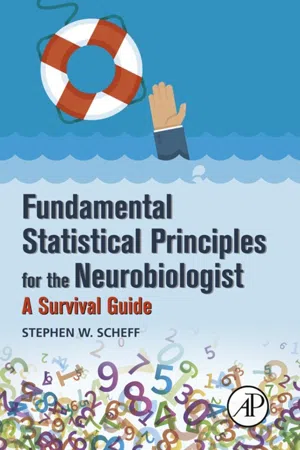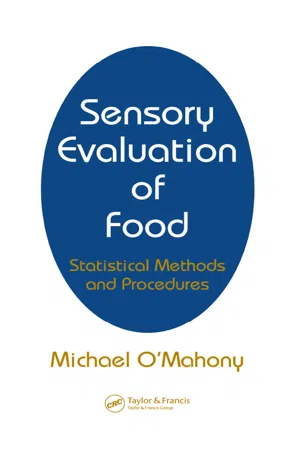Technology & Engineering
Two Way ANOVA
Two-way ANOVA is a statistical method used to analyze the influence of two categorical independent variables on a continuous dependent variable. It allows for the examination of interactions between the two independent variables, providing insights into how they jointly affect the dependent variable. This technique is commonly employed in experimental research to assess the impact of multiple factors on an outcome.
Written by Perlego with AI-assistance
Related key terms
Related key terms
1 of 4
Related key terms
1 of 3
10 Key excerpts on "Two Way ANOVA"
- eBook - ePub
Fundamental Statistical Principles for the Neurobiologist
A Survival Guide
- Stephen W. Scheff(Author)
- 2016(Publication Date)
- Academic Press(Publisher)
Chapter 7Two-Way Analysis of Variance
Stephen W. Scheff University of Kentucky Sanders–Brown Center on Aging, Lexington, KY, USAAbstract
The two-way analysis of variance (ANOVA) is an extremely powerful and important statistical technique used to look at the possible interaction of two different variables. It differs in several important ways from a one-way ANOVA. The concept of interaction, which is explained in detail in this chapter, totally changes the interpretation of the data. This chapter describes how to interpret these data and how to report the findings for scientific publication. The multifactorial design becomes more complicated if there are repeated measures for one or both of the variables. Specific examples are given for each of these different types of designs.Keywords
Interaction; Interpreting two-way ANOVA; Multifactorial design; Repeated measure two-way ANOVA; Two-way ANOVAOutlineConcept of Interaction 137Difference between One-Way and Two-Way Analysis of Variance 139Interpreting a Two-Way Analysis of Variance 141Two-Way Repeated Measure Analysis of Variance 146Both Factors Repeated 146Single Factor Repeated 154Summary 155One-way ANOVAs are always jealous of two-way ANOVAs because they can have interactions with their variables. AnonymousUp to this point the discussion has really centered on the simplest form of an analysis of variance (ANOVA), the one-way ANOVA, where you have multiple levels of a single factor (e.g., Antioxidant). There are always experimental designs that want to look at outcome after manipulating two or more different factors. If there are only two independent variables (with multiple levels) being manipulated, then this type of ANOVA is called a two-way ANOVA . If there are three or more factors (with different levels) being evaluated, then it is called a multifactorial ANOVA . Often times a biostatistician will call it a two-way factorial design , but it is still just a two-way ANOVA. When only a single dependent variable is quantified, the analysis is termed a univariate analysis . Naturally, if two dependent variables are analyzed simultaneously (e.g., cell firing, cell size), then it is called a bivariate analysis - Sally A. Lesik(Author)
- 2018(Publication Date)
- Chapman and Hall/CRC(Publisher)
12Two-Way Analysis of Variance and Basic Time Series
12.1 Two-Way Analysis of VarianceRecall that a one-way analysis of variance (ANOVA) compares the means of a continuous variable that is classified by only one categorical factor . However, there may be situations where you may want to compare the means of a variable that is classified by two categorical factors . To do this, we could conduct a two-way ANOVA .Example 12.1
Suppose the manager of a manufacturing company is interested in estimating whether there is a difference in the mean number of defective products that are produced at three different manufacturing plants using five different types of machines. The data provided in Table 12.1 consists of a random sample of the number of defective products that were produced by the plant and machine at two different collection times.We are interested in testing whether there is a difference in the mean number of defective products that are produced by the machine and by the plant. We can describe one factor that represents the five different types of machines (this is referred to as the row factor ) and another factor that represents the three different plants (this is referred to as the column factor ).In a fashion similar to that of a one-way ANOVA, let δ describe the effect of the different levels of the machine (the row factor), and let β describe the effect of the different levels of the plant (column factor). We can then model the average number of defective items for the i th row and the j th column by using the following regression equation:TABLE 12.1 Number of Defective Products Produced by Machine and by Planty= μ +i , j , kδ i+β j++(δ β)i , jεi , j , kwhereyis the k th observation at leveli , j , kδ iand levelβ j, μ represents the mean common to all populations,represents the interaction between the row factor δ at level i and the column factor β at level j , and(δ β)i , jεrepresents the error component that corresponds to the k th observation of the row factor at level i and the column factor at level ji , j , k- eBook - ePub
- David L. Johnson(Author)
- 2016(Publication Date)
- Wiley(Publisher)
Chapter 7 Two-Way Analysis of VarianceObjectives
At the end of this chapter you should be able to:- Distinguish between one-way and two-way ANOVA
- Conduct parametric and nonparametric two-way ANOVA and post hoc comparisons, and interpret the results
- Discuss the influence of blocking on two-way ANOVA and interpretation of the results
7.1 Introduction
We now continue the discussion of comparing several samples, this time using factorial ANOVA in which the influences of more than one independent categorical variable are examined. Recall that one-way ANOVA is used when we have continuous outcome data and only one independent categorical predictor variable, that is, when we are asking questions such as the following: “Does the age of a home (for example, pre-1980s versus 1980s or newer) have an influence on its susceptibility to infiltration of outdoor pollutants into the indoor space?” or “Does the amount of a welder's fluoride flux fume exposure vary with the type of flux-coated welding rods?” When there are multiple potential influences on the outcome, we may need to ask a broader question, such as the following: “Does the age and/or construction type of a home have an influence on its susceptibility to infiltration of outdoor pollutants into the indoor space?” or “Does the amount of a welder's fluoride flux fume exposure vary with the type and/or brand of flux-coated welding rods?” When more than one factor can influence the values being compared we must use a factorial ANOVA technique.7.2 Parametric Two-Way ANOVA
Although parametric ANOVA techniques are available for looking at the influence of more than two predictor variables, in this chapter we limit our discussion to basic two-way ANOVA, which is more likely to be used in IH/EHS work. Three-way and higher parametric ANOVA are performed using regression techniques and are discussed in Chapter 9 - eBook - ePub
- Jim Fowler, Lou Cohen, Philip Jarvis(Authors)
- 2013(Publication Date)
- Wiley(Publisher)
Analysis of variance (ANOVA) overcomes these difficulties by allowing comparisons to be made between any number of sample means, all in a single test. When it is used in this way to compare the means of several samples statisticians speak of a one-way ANOVA.ANOVA is such a flexible technique that it may also be used to compare more than one set of means. Referring to our island races again, it is possible to compare at the same time the mean lengths of samples of males and females of each race obtained from the islands. When the influence of two variables upon a sample mean is being analysed, such as island of origin and sex in our hypothetical example, the technique involved is described as a two-way ANOVA. Three-way, four-way (and so on) treatments are also possible but they get progressively more complicated. We restrict our examples in this text to one-way and two-way treatments.17.2 How ANOVA works
How analysis of variance is used to investigate differences between means is illustrated in the following example.Example 17.1
Compare the individual variances of the three samples below with the overall variance when all 15 observations n = 15 are aggregated.The means of Samples 1 and 2 are similar; the mean of Sample 3 is much lower; the mean of the aggregated observations is intermediate in value. The variances of the three samples are identical (10.00) and therefore the ‘average variance’ is 10.00. The variance of the aggregated observations however is larger (16.0) than the average sample variance. The increase is due to the difference between the means of the samples, in particular, the difference between the mean of Sample 3 and the other two means. The samples thus give rise to two sources of variability:(i) the variability around each mean within a sample (random scatter);(ii) the variability between the samples due to differences between the means of the populations from which the samples are drawn.In other words:ANOVA involves the dividing up or partitioning the total variability of a number of samples into its components. If the samples are drawn from normally distributed populations with equal means and variances, the within variance is the same as the between variance. If a statistical test shows that this is not the case, then the samples have been drawn from populations with different means and/or variances. If it is assumed that the variances are equal (and this is an underlying assumption in ANOVA) then it is concluded that the discrepancy is due to differences between means. - eBook - ePub
Social and Behavioral Statistics
A User-Friendly Approach
- Steven P. Schacht(Author)
- 2018(Publication Date)
- Routledge(Publisher)
12Factorial Analysis of Variance: ANOVA with More than One Independent Variable
Chapter 11 explored the ANOVA technique for testing hypotheses when there are more than two groups. ANOVA enables one to determine whether group means are significantly different from one another, while reducing the overall risk of committing a Type I Error (which is saying that means are different, when in fact they are not). While the ANOVA is concerned with situations where there is one independent variable, the Factorial ANOVA deals with hypotheses involving more than one independent variable. We will limit discussion of factorial ANOVA to situations where there are two independent variables (often referred to as a Two-Way ANOVA). However, the procedures presented can be adapted to test more complex hypotheses involving more than two independent variables.This chapter first outlines the logic and advantages of using factorial ANOVA procedures and distinguishes between the influence of independent variables examined in isolation (main effects) and the influence of independent variables when they are considered together (interaction effects). Then, using a nineteen-step procedure, the calculations for completing a two-way factorial ANOVA are presented.Advantages and Assumptions of the Factorial ANOVA
The next time you get a chance, ask any of your instructors about the relationship between any single independent variable (IV) and a related dependent variable (DV); odds are, no matter what variables you pick, the answer will be “it depends.” This is true for just about all relationships between variables in the social and behavioral sciences. Whether an IV has an effect on a DV almost always depends on a variety of factors. For example, the outcome may depend on who the participants are, what characteristics the participants have, where the study is being conducted, when the study is being conducted, and often even how and why the study is being conducted. As such, when researchers find new relationships between variables, the next step is to find out whether that relationship holds all of the time or whether it depends on any other factors, such as those just mentioned. - eBook - ePub
Statistics for Machine Learning
Implement Statistical methods used in Machine Learning using Python (English Edition)
- Himanshu Singh(Author)
- 2021(Publication Date)
- BPB Publications(Publisher)
We have seen how one factor affects different samples from different populations. What if we have two factors instead of only one factor? In such cases, we will use 2-way ANOVA for our analysis. We will look at 2-way ANOVA in detail in the next section.Two-way ANOVA
Let’s take an example wherein coders love playing video games. Video games have two categories: multiplayer games and single player games, and coders have two levels: male and female coders. In this scenario, we will use the 2-way ANOVA analysis to derive a conclusion. In the current scenario, both factors have two levels, so we call it 2X 2 Factorial Design of ANOVA. If we generalize this, we can say that if Factor 1 has ‘a’ levels, and Factor 2 has ‘b’ levels, the resulting analysis table will be an a × b factorial design.Depending on how these factors and levels affect the response variable, we can classify them into two categories:- Main effects
- Interaction effects
Main Effects
If we analyze the change in response variable when we change the levels of both Factor 1 and Factor 2 together, it’s called the main effect .Interaction Effects
However, if we analyze the response variable as we change the levels of the first factor and if the change in the response is different for different levels of the second factor, we say that both the factors have interaction effect between them. Let’s understand this with the help of an example.Let’s first understand the main and interaction effects with the help of an example. Suppose I want to understand the effect of tuitions and online courses on exam results. The following table explains the outcome:
Table 7.5 Let’s look at the main effect of tuitions first. For this, we will look at the means of the No and Yes values of tuitions and subtract them from each other:Online Courses Tutions No Yes No 35 33 41 45 Yes 40 38 45 48 - eBook - ePub
Design of Experiments
A Realistic Approach
- Virgil L. Anderson, Robert A. McLean(Authors)
- 2018(Publication Date)
- CRC Press(Publisher)
Chapter 2 SOME INTERMEDIATE DATA ANALYSIS CONCEPTSIn Chapter 1 we described a few ideas in data analysis using the one-way classification from a completely randomized design. In this chapter we again utilize only the completely randomized design and discuss the two-way classification and its advantages over the one-way. The concepts used in analyzing two-way classified data are more involved than those encountered in the one-way.For instance, in most research problems of any consequence, the information on the combined effects of two factors controlled in the experiment (two-factor interactions) on the response variable usually contributes more to solving the problem than the information on the individual effects of the factors themselves (main effects).By extending the analytical procedures to many controlled factors in an experiment, the investigator is able to obtain the information on all the two-factor interactions simultaneously and additional information on the three-factor interactions also. Only recently (to our knowledge) have some research workers, for example, highway research engineers Hadley et al. (1969), interpreted three-factor interactions thoroughly enough to want to use them in the mathematical models to help to explain the responses obtained. As a general rule, however, the four-factor interactions and higher tend to be small contributors to the underlying ANOVA models used to explain the mathematical phenomenon. These high order interaction effects are frequently assumed zero to allow an estimate of the error if only one experimental unit has been used for each combination of the factor levels, often called the treatment combination. Details of this extended type experiment with many factors are given in Chapter 4 on factorial experiments.In this chapter we are especially interested in expressing the interaction concept. In the first section two factors are investigated thoroughly, using only one experimental unit per treatment combination, or one observation per cell, and in the following section, concepts on more than one observation per cell are covered. - Christophe Lalanne, Mounir Mesbah(Authors)
- 2016(Publication Date)
- ISTE Press - Elsevier(Publisher)
4Analysis of Variance and Experimental Design
Abstract:
In this chapter, we will address analysis of variance and a few elementary notions about the design of experiments. Only the ANOVA cases with one and two classification factors (fixed effects, interaction model) are discussed. For a single-factor ANOVA, the linear tendency test is approached using two techniques: linear regression and the contrast method. The case of multiple comparisons between treatments is also discussed, considering only the Bonferroni method to protect the inflation of the Type I error risk. It remains, however, important to achieve an in-depth data description in all cases prior to performing the ANOVA model (numerical summaries, graphics methods, etc.).Keywords
ANOVA; Data representation; Data representation format; Data structuring; Descriptive statistics; Diagnostic model; Linear trend test; Non-parametric one-way ANOVA; Two-way ANOVAIn this chapter, we will address analysis of variance and a few elementary notions about the design of experiments. Only the ANOVA cases with one and two classification factors (fixed effects, interaction model) are discussed. For a single-factor ANOVA, the linear tendency test is approached using two techniques: linear regression and the contrast method. The case of multiple comparisons between treatments is also discussed, considering only the Bonferroni method to protect the inflation of the Type I error risk. It remains, however, important to achieve an in-depth data description in all cases prior to performing the ANOVA model (numerical summaries, graphics methods, etc.).- Available until 29 Sep |Learn more
- S Alexander Haslam, Craig McGarty(Authors)
- 2018(Publication Date)
- SAGE Publications Ltd(Publisher)
10 Comparing Two or More Means by Analysing Variances: ANOVAKey goals for this chapter
- Outline analysis of variance – a statistical procedure that allows researchers to establish how likely it is that observed differences between two or more groups would have arisen by chance.
- Show how different types of analysis of variance (ANOVA) are used to examine data that are structured in different ways.
- Explain the process of interpreting the results of analysis of variance.
In Chapter 8 we saw how it was possible to compare two means. The statistical procedure that we addressed in some detail was the t-test. We saw in that chapter, though, that this procedure is limited to comparing just two means at a time. The t-test is fine for giving us an insight into whether the mean scores of two groups are plausibly different or whether the mean scores of the same group on two variables are different, but it has its limits.In particular, what should we do when we need to compare more than two means? The typical case where we might need to do this is where we have conducted an experiment involving many conditions. Participants in each group have been randomly assigned to a particular condition of an experiment. The conditions (representing different levels of the experimental factors) can be considered as levels of a categorical independent variable (or variables) and we want to know whether this variable (or variables) has affected some dependent variable that we have measured. That is, does our independent variable have an effect on the dependent variable – in other words, does the treatment make a difference?One solution that might occur to you is that because you have lots of means to compare you could perform lots of t-tests. Thus, if we had the means for three groups (we can call them groups A, B and C) we could do three t-tests comparing A with B, A with C, and B with C. This approach has two problems that we can address here, the first of which is quite easy to see. Each of the three t- - eBook - ePub
Sensory Evaluation of Food
Statistical Methods and Procedures
- Michael O'Mahony(Author)
- 2017(Publication Date)
- CRC Press(Publisher)
11Analysis of Variance: Two-Factor Design with Interaction
11.1 What is Interaction?
We will now consider the two-factor ANOVA with interaction. Before considering this design in detail, we will examine exactly what we mean by “interaction.” Interaction takes place between factors. Two factors interact if the trend between treatments in one factor varies depending on which treatment is present in the other factor.It is important to note that the name “two-factor ANOVA with interaction” does not imply that interaction actually occurs; it merely means that interaction is considered in the calculation. The name “two-factor ANOVA without interaction” considered in Chapter 10 does not imply that there is no interaction; it merely means that interaction is not examined in the calculation.We could be comparing three wines, A , B , and C . Should all judges rate A the worst and C the best, the trend between wines is the same for all judges. The trend does not depend on which judge is doing the testing; in statistical jargon, “wines” and “judges” are said not to interact. On the other hand, if some judges rate A the worst wine and C the best, while others rate C the worst and A the best, the trend between the wines is not the same for all judges; there is no consistency over the judges. Should you ask how the wines are rated, the answer would depend on which judge was doing the rating. The trend over wines depends on which particular judge does the tasting; “wines” and “judges” are said to interact.Interaction can be understood by considering a graph of the mean values under various combinations of treatments. Consider our wine example. Let us imagine that three judges (or subjects S 1 , S 2 , S 3 ) taste wines A , B , and C and rate them according to their quality (using a scale that fulfills assumptions of normality and homoscedasticity, so that we can use ANOVA). Let us suppose that the judges use the quality rating scale differently: S 1 tends to give high scores, S 3 low scores, and S 2 middle-range scores. A graph of scores for S 1 will be above that of S 2 , which in turn will be above that of S 3 . Let us suppose that all judges rate wine C as the best, A the worst, and B in the middle, so that C scores are the highest and A
Index pages curate the most relevant extracts from our library of academic textbooks. They’ve been created using an in-house natural language model (NLM), each adding context and meaning to key research topics.
Explore more topic indexes
Explore more topic indexes
1 of 6
Explore more topic indexes
1 of 4









